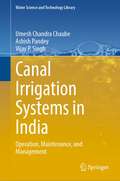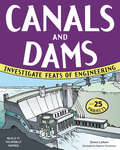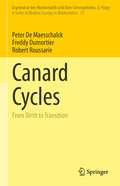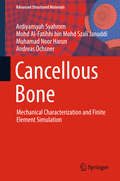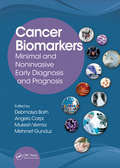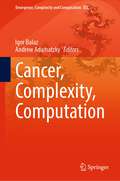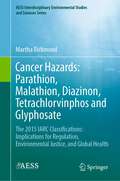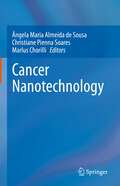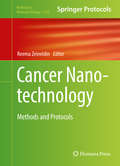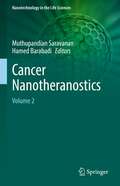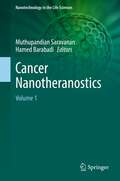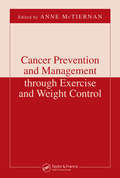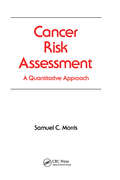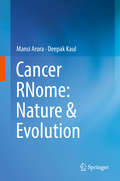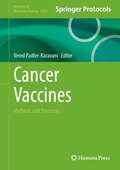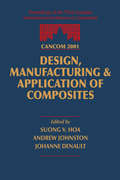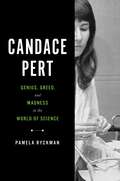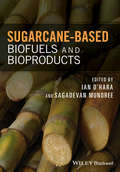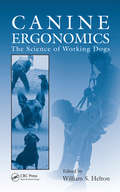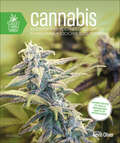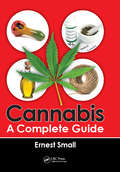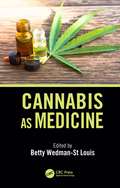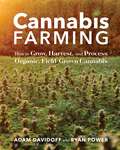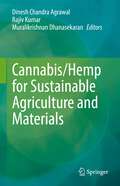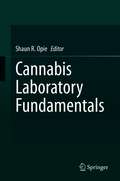- Table View
- List View
Canal Irrigation Systems in India: Operation, Maintenance, and Management (Water Science and Technology Library #126)
by Umesh Chandra Chaube Ashish Pandey Vijay P. SinghThe book focuses broadly on the preliminaries of the canal irrigation systems in India with a focus on their operation, maintenance, and management of the canal systems. The chapters in this book are classified under four sections, viz., (i). preliminaries of the canal irrigation systems, (ii) operation of the canal irrigation systems, (iii) maintenance of the canal irrigation systems, and (iv) management of the canal irrigation systems. The preliminaries of the canal irrigation systems include an integrated view of irrigation and agriculture, irrigation management in India: problems, issues, a brief history, and some lessons, irrigation administration, organizational structure for management of irrigated agriculture, and farmers’ participation. The operation of the canal irrigation systems includes the operation of dams and barrages, canal operation, water distribution planning, measurement of flow and sediment in canals, and performance evaluation of the canal irrigation system, use of groundwater in the canal command area. The canal irrigation systems' maintenance includes dams, barrages, related equipment, canals and related structures, field drainage, diagnostic analysis of canal irrigation system, soil and water quality management, soil moisture, and measurement. The management of the canal irrigation systems includes rehabilitation and modernization and a case study on rehabilitation, conjunctive use management, operation, and maintenance budgeting, and financing. The book is expected to be useful for academicians, water practitioners, scientists, water managers, environmentalists, administrators, NGOs, researchers, and students who are actively involved in the operation, maintenance, and management of the canal irrigation system for addressing the challenges being faced in the irrigated agricultural while addressing issues of canal irrigation systems in South East Asia.
CANALS AND DAMS
by Donna Latham Andrew ChristensenCanals and Dams: Investigate Feats of Engineering invites children ages 9 and up to explore the innovation and physical science behind the amazing waterways and barriers our world depends on. Trivia and fun facts illustrate engineering ingenuity and achievements from ancient aqueducts to the Suez Canal and the Hoover Dam. Readers will discover that engineers and builders alike put their lives on the line to advance civilization, experiencing triumphs and tragedies in building big. Through dazzling success and heartbreaking failure, they developed increasingly sophisticated tools and building methods.Activities and projects encourage children to explore the engineering process and to try, try again through trial and error. They'll engage in hands-on explorations of buoyancy, Newton's third law of motion, and forces that push and pull structures. They'll create a paper-cup zip line, build an arch, and simulate a tsunami, while experimenting with gravity, hydroponics, and velocity. In Canals and Dams: Investigate Feats of Engineering, children will gain an appreciation for the important field of engineering as they develop their own building skills.
Canard Cycles: From Birth to Transition (Ergebnisse der Mathematik und ihrer Grenzgebiete. 3. Folge / A Series of Modern Surveys in Mathematics #73)
by Freddy Dumortier Robert Roussarie Peter De MaesschalckThis book offers the first systematic account of canard cycles, an intriguing phenomenon in the study of ordinary differential equations. The canard cycles are treated in the general context of slow-fast families of two-dimensional vector fields. The central question of controlling the limit cycles is addressed in detail and strong results are presented with complete proofs.In particular, the book provides a detailed study of the structure of the transitions near the critical set of non-isolated singularities. This leads to precise results on the limit cycles and their bifurcations, including the so-called canard phenomenon and canard explosion. The book also provides a solid basis for the use of asymptotic techniques. It gives a clear understanding of notions like inner and outer solutions, describing their relation and precise structure.The first part of the book provides a thorough introduction to slow-fast systems, suitable for graduate students. The second and third parts will be of interest to both pure mathematicians working on theoretical questions such as Hilbert's 16th problem, as well as to a wide range of applied mathematicians looking for a detailed understanding of two-scale models found in electrical circuits, population dynamics, ecological models, cellular (FitzHugh–Nagumo) models, epidemiological models, chemical reactions, mechanical oscillators with friction, climate models, and many other models with tipping points.
Cancellous Bone: Mechanical Characterization and Finite Element Simulation (Advanced Structured Materials #82)
by Andreas Öchsner Muhamad Noor Harun Ardiyansyah Syahrom Mohd Al-Fatihhi bin Mohd Szali JanuddiThis book provides comprehensive mechanobiological insights into bone, including the microstructure of cancellous bone and its realistic loading in the human body. This approach considers different types of loads, i. e. static and dynamic, and the response under uniaxial and multiaxial loading conditions. The book also reviews additional factors influencing biomechanical properties, e. g. fluid transport. In closing, the mechanobiological approach is discussed in the context of the finite element method.
Cancer Biomarkers: Minimal and Noninvasive Early Diagnosis and Prognosis
by Debmalya Barh Angelo Carpi Mukesh Verma Mehmet GunduzGleaning information from more than 100 experts in the field of cancer diagnosis, prognosis, and therapy worldwide, Cancer Biomarkers: Non-Invasive Early Diagnosis and Prognosis determines the significance of clinical validation approaches for several markers. This book examines the use of noninvasive or minimally invasive molecular cancer m
Cancer, Complexity, Computation (Emergence, Complexity and Computation #46)
by Igor Balaz Andrew AdamatzkyThis book presents unique compendium of groundbreaking ideas where scientists from many different backgrounds are united in their interest in interdisciplinary approaches towards origins and development of cancers, innovative ways of searching for cancer treatment and the role of cancer in the evolution. Chapters give an unequivocal slice of all areas that relate to a quest for understanding cancer and its origin as many-fold nonlinear system, complexity of the cancer developments, a search for cancer treatment using artificial intelligence and evolutionary optimisation, novel modelling techniques, molecular origin of cancer, the role of cancer in evolution of species, interpretation of cancer in terms of artificial life and artificial immune systems, swarm intelligence, cellular automata, computational systems biology, genetic networks, cellular computing, validation through in vitro/vivo tumour models and tumour on chip devices. The book is an inspiring blend of theoretical and experimental results, concepts and paradigms. Distinctive features The book advances widely popular topics of cancer origin, treatment and understanding of its progress The book is comprised of unique chapters written by world top experts in theoretical and applied oncology, complexity theory, mathematics, computer science. The book illustrates attractive examples of mathematical and computer models and experimental setups.
Cancer Hazards: The 2015 IARC Classifications: Implications for Regulation, Environmental Justice, and Global Health (AESS Interdisciplinary Environmental Studies and Sciences Series)
by Martha RichmondThis book focuses on a monograph published in 2017 by the International Agency for Research on Cancer (IARC), an agency of the World Health Organization (WHO), discussing its carcinogen hazard classification of four pesticides: parathion, malathion, diazinon, and tetrachlorvinphos as well as the herbicide glyphosate. The monograph provided a detailed discussion of considerations and conclusions made by a group of experts who met in 2015 to evaluate these compounds. Although not universally true, many of these substances, from the time of their commercial introduction to their present-day use, have spread significantly in the environment, affecting animals and plants in the larger ecosystem, the overall health of the environment, and human health. This book develops each of these issues before turning to the IARC review process, both the general process and its evolution over time, and compound selection criteria and deliberations regarding the substances discussed in the 2017 monograph. Final book sections detail scientific and private sector reactions to and implications of the IARC classifications. Hazard identification is contrasted with various models of quantitative risk assessment. The last chapters highlight the importance of hazard identification for members of domestic and global underserved communities involved in farming and landscape work, where exposures may vary widely, are not well-regulated, and where health outcomes are often not carefully documented.
Cancer Nanotechnology
by Ângela Maria Almeida de Sousa Christiane Pienna Soares Marlus ChorilliCancer nanotechnology is a growing, emerging area of cross-disciplinary research that aims to develop efficient, specific and noninvasive approaches to restore the health and well-being of all cancer patients through more effective diagnosis and treatment. This new volume serves as a fundamental guide to cutting-edge topics in cancer nanotechnology, including advances in therapy, the use of nanoparticles and nanomaterials, future directions for nanocarriers in cancer therapy, and the application of DNA and RNA nanovaccines. Organized into four sections, the volume presents an overview of research and innovation in the emerging field of nanotechnology as a powerful tool in the diagnosis, imaging and treatment of cancer. International experts author chapters addressing targets of cancer therapy, materials for cancer nanotechnology, strategies for cancer therapy using nanotechnology, and innovative nanotechnologies for cancer diagnosis and treatment. The volume will be useful for a broad audience, including cross-disciplinary researchers, trainees, health professionals, and experts in industry.
Cancer Nanotechnology: Methods and Protocols (Methods in Molecular Biology #1530)
by Reema ZeineldinThis detailed volume presents protocols for advancing the utility of nanotechnology in cancer research toward improving our understanding of cancer biology, prevention, diagnosis, and therapy. There are continuous new discoveries in the field of nanotechnology, thus creating new imaging systems or therapies, and this book focuses on how to employ certain discoveries for studying cancer by presenting principles along with techniques to allow for the transformation of any new discoveries in the field into cancer-studying tools with the hope of bringing in the involvement of biomedical scientists who can enhance the speed of discoveries toward cancer diagnosis and therapy. Written for the highly successful Methods in Molecular Biology series, chapters include introductions to their respective topics, lists of the necessary materials and reagents, step-by-step, readily reproducible laboratory protocols, and tips on troubleshooting and avoiding known pitfalls. Authoritative and motivating, Cancer Nanotechnology: Methods and Protocols serves as an ideal resource for biomedical scientists interested in the potential of this field as well as for physical scientists and engineers interested in employing nanotechnology in cancer diagnosis and therapy.
Cancer Nanotheranostics: Volume 2 (Nanotechnology in the Life Sciences)
by Muthupandian Saravanan Hamed BarabadiCancer Nanotheranostics, Volume 2 continues the discussion of the important work being done in this field of cancer nanotechnology. The contents of these two volumes are explained in detail as follows.In the first volume of Cancer Nanotheranostics, we discuss the role of different nanomaterials for cancer therapy including lipid-based nanomaterials, protein and peptide-based nanomaterials, polymer-based nanomaterials, metal-organic nanomaterials, porphyrin-based nanomaterials, metal-based nanomaterials, silica-based nanomaterials, exosome-based nanomaterials, and nano-antibodies.This important second volume discusses nano-based diagnosis of cancer, nano-oncology for clinical applications, nano-immunotherapy, nano-based photothermal cancer therapy, nanoerythrosomes for cancer drug delivery, regulatory perspectives of nanomaterials, limitations of cancer nanotheranostics, safety of nanobiomaterials for cancer nanotheranostics, multifunctional nanomaterials for targeting cancer nanotheranostics, and the role of artificial intelligence in cancer nanotheranostics.Volume 2 is a vital continuation of this two-volume set. Together, these two volumes create a comprehensive and unique examination of this important area of research.
Cancer Nanotheranostics: Volume 1 (Nanotechnology in the Life Sciences)
by Muthupandian Saravanan Hamed BarabadiNanotechnology is an interdisciplinary research field that integrates chemistry, engineering, biology, and medicine. Nanomaterials offer tremendous opportunity as well as challenges for researchers. Of course, cancer is one of the world's most common health problems, responsible for many deaths. Exploring efficient anticancer drugs could revolutionize treatment options and help manage cancer mortality. Nanomedicine plays a significant role in developing alternative and more effective treatment strategies for cancer theranostics. This book mainly focuses on the emerging trends using nanomaterials and nanocomposites as alternative anticancer material’s. The book is divided into three main topic areas: how to overcome existing traditional approaches to combat cancer, applying multiple mechanisms to target the cancer cells, and how nanomaterials can be used as effective carriers. The contents highlight recent advances in interdisciplinary research on processing, morphology, structure, and properties of nanostructured materials and their applications to combat cancer.Cancer Nanotheranostics is comprehensive in that it discusses all aspects of cancer nanotechnology. Because of the vast amount of information, it was decided to split this material into two volumes. In the first volume of Cancer Nanotheranostics, we discuss the role of different nanomaterials for cancer therapy, including lipid-based nanomaterials, protein and peptide-based nanomaterials, polymer-based nanomaterials, metal-organic nanomaterials, porphyrin-based nanomaterials, metal-based nanomaterials, silica-based nanomaterials, exosome-based nanomaterials and nano-antibodies. In the second volume, we discuss the nano-based diagnosis of cancer, nano-oncology for clinical applications, nano-immunotherapy, nano-based photothermal cancer therapy, nano-erythrosomes for cancer drug delivery, regulatory perspectives of nanomaterials, limitations of cancer nanotheranostics, the safety of nano-biomaterials for cancer nanotheranostics, multifunctional nanomaterials for targeting cancer nanotheranostics, and the role of artificial intelligence in cancer nanotheranostics.
Cancer Prevention and Management through Exercise and Weight Control
by Anne Mctiernan“..it is increasingly clear that cancer is also a disease of inertia. In this book, a broadly multidisciplinary group presents the evidence and provides the recommendations. … The antidote to diseases of inertia is movement — let’s move!” John Potter, M.D.,Ph.D., from the Foreword The American Cancer Society estimates that a third of all cancer deaths could be prevented through avoidance of obesity and the rejection of sedentary lifestyles. The World Health Organization also supports this claim. Additionally, these and other organizations now recognize the role that activity can play in improving the quality of life for cancer patients. Cancer Prevention and Management through Exercise and Weight Control provides us with the support necessary to make a call to action. It brings together the contributions of world-class researchers to lay out the evidence and a plan of attack for coping with this crisis. The text begins by focusing on the research methods used in assessing the complex associations between activity, energy balance, and risk and prognosis. In comprehensive literature reviews, the authors consider the role of physical activity in the incidence of individual cancers, then explore the mechanisms that might explain this connection. They continue with a look at the relation between weight and cancer incidence, including a consideration of genetics. Research is also provided linking physical activity and weight control to a cancer patient’s quality of life and prognosis. The work concludes with ideas on how a plan of action might be implemented at the individual, clinical, and public health levels. It also provides guidance on incorporating exercise and diet recommendations into clinical oncology practice.
Cancer Risk Assessment: A Quantitative Approach (Occupational Safety And Health Ser. #20)
by Samuel C. MorrisBased on the National Academy of Sciences approach to quantitative risk assessment. Emphasizes how an accurate assessment of cancer risk must draw on a wide range of disciplines, such as biology, chemistry, physics, engineering, and the social sciences. Provides tables of Poisson confidence limit fa
Cancer RNome: Nature & Evolution
by Mansi Arora Deepak KaulIn the last decade, researchers working in the field of cancer biology have shifted their focus from genetic defects to epigenetic dysregulation, especially that of non-coding RNAs (ncRNAs). This book encompasses a comprehensive review of the transcriptional landscape of the cell and its involvement in the cancer pathophysiology. The first two chapters elucidate the basics of biosynthesis, mechanism of action and modulation of the epigenetic regulation of gene expression by coding as well as non-coding RNAs. The third chapter discusses the aberrant expression of the cellular RNome in the cancer cells and highlights its role in the orchestration of processes involved in evolution as well as the sustenance of cancer cells. The fourth chapter describes the recent advances in the field of translating the transcriptome into diagnostic/prognostic biomarkers and as targets for novel anti-cancer therapies. The final chapter then reviews the emerging experimental approaches to screen, identify and explore the functions of ncRNAs. Providing valuable insights into the field of RNome in the context of cancer, this book is helpful to students, researchers and clinicians..
Cancer Vaccines: Methods and Protocols (Methods in Molecular Biology #2926)
by Vered Padler-KaravaniThis volume provides readers with an overview on the latest advances in cancer vaccines, and the major issues that need to be addressed in their development. The chapters in this book cover recent progress in immunotherapy; methods for generating relevant mouse models and engineering viral-based vaccines; oncolytic virus; glycosylation-based vaccines; and clinical production of dendritic cell cancer vaccines. Written in the highly successful Methods in Molecular Biology series format, chapters include introductions to their respective topics, lists of the necessary materials and reagents, step-by-step, readily reproducible laboratory protocols, and tips on troubleshooting and avoiding known pitfalls.Cutting-edge and thorough, Cancer Vaccines: Methods and Protocols is a valuable resource for expert and novice researchers and scientists who are looking to expand their knowledge or learn more about this important and developing field.
CANCOM 2001 Proceedings of the 3rd Canadian International Conference on Composites
by S.V. HoaThis book contains technical papers, presented at the third Canadian International Conference on Composites held in Canada in 2001, on topics including liquid composite molding, process modelling, virtual manufacturing, novel materials and processes, and metal matrix composites.
Candace Pert: Genius, Greed, and Madness in the World of Science
by Pamela Ryckman"...a truly insightful narrative on what it can mean to be a woman at the cutting edge of science." —THE WALL STREET JOURNALThe story of maverick scientist Candace Pert, whose groundbreaking research and book Molecules of Emotion introduced the world to the mind-body connection, opioid receptors, and peptide T, and her fight for recognition in a toxic healthcare system. Candace Pert stood at the dawn of three revolutions: the women&’s movement, integrative health, and psychopharmacology. A scientific prodigy, she was 30 years ahead of her time, preaching a holistic, interdisciplinary approach to healthcare and medicine long before yoga hit the mainstream and &“wellness&” took root in our vernacular. Her bestselling book Molecules of Emotion made her the mother of the Mind/Body Revolution, launching a paradigm shift in medicine. Deepak Chopra credits her with creating his career, and he said as much in his eulogy at her funeral. Candace began her career as an unbridled maverick. In 1972, as a 26-year-old graduate student at Johns Hopkins, she discovered the opiate receptor, revolutionizing her field and enabling pharmacologists to design new classifications of drugs from Prozac to Viagra to Percocet and OxyContin. The tragic irony of her breakthrough, touted as the first step to end heroin addiction, is that it helped spawn a virulent epidemic of drug dependence. Facing the largest public health crisis of the 21st century, Candace was incensed that the Hippocratic oath—&“first, do no harm&”—would succumb to greed, and as witness to this abuse of power, she was one of few scientists courageous enough to protest. Later, as Chief of Brain Biochemistry at the National Institutes of Health, Candace created Peptide T, the non-toxic treatment for HIV featured in Dallas BuyersClub. As the AIDS pandemic raged, triggering panic across Reagan-era America, the U.S. government poured massive amounts of money into finding a cure, sparking a battle among scientists for funding and power. Bested by rivals with competing drugs yet desperate to help, Candace went rogue, becoming a lynchpin in the black market for Peptide T. After a scandalous departure from her tenured position at the NIH, Candace launched a series of private companies with Michael Ruff, her second husband and collaborator. Naïve to the world of business, she was manipulated by investors keen to wrest control of her discoveries. But Candace too became tainted, believing that her noble ends would justify devious means. Like a mythic hero, she succumbed to a fatal flaw, and her greatest strengths—singularity of purpose and blind faith in her own virtuosity—would prove to be her undoing.
Cane-based Biofuels And Bioproducts
by Sagadevan MundreeSugarcane has garnered much interest for its potential as a viable renewable energy crop. While the use of sugar juice for ethanol production has been in practice for years, a new focus on using the fibrous co-product known as bagasse for producing renewable fuels and bio-based chemicals is growing in interest. The success of these efforts, and the development of new varieties of energy canes, could greatly increase the use of sugarcane and sugarcane biomass for fuels while enhancing industry sustainability and competitiveness. Sugarcane-Based Biofuels and Bioproducts examines the development of a suite of established and developing biofuels and other renewable products derived from sugarcane and sugarcane-based co-products, such as bagasse. Chapters provide broad-ranging coverage of sugarcane biology, biotechnological advances, and breakthroughs in production and processing techniques. This text brings together essential information regarding the development and utilization of new fuels and bioproducts derived from sugarcane. Authored by experts in the field, Sugarcane-Based Biofuels and Bioproducts is an invaluable resource for researchers studying biofuels, sugarcane, and plant biotechnology as well as sugar and biofuels industry personnel.
Canine Ergonomics: The Science of Working Dogs
by William S. HeltonSince Canis lupus familiaris first shared a fire with man more than 15,000 years ago, dogs have been trusted and valued coworkers. Yet the relatively new field of canine ergonomics is just beginning to unravel the secrets of this collaboration. As with many new fields, the literature on working dogs is scattered across several non-overlapping disci
Cannabis: Everything You Need to Grow Marijuana Indoors and Outdoors (Green Thumb Guides)
by Kevin OliverCultivate your personal cannabis crop with expert techniques and know-how.As marijuana laws in the United States become less restrictive, more people are searching for basic marijuana gardening instructions. Cultivating marijuana isn't like growing other plants, especially if you desire maximum potency and yield. The cannabis plant requires special care, from the soil, water, and nutrients used to the temperature, light, and ventilation levels. Cannabis covers it all in a simple, concise way to help you increase both the quality and yield of your personal harvest.Here&’s what you&’ll find in this updated visual guide:Instructions on how to grow and maintain a small marijuana garden for your own noncommercial useThe full spectrum of options available for growing marijuana, from indoor, climate-controlled systems to open-air and outdoor growingTime-tested techniques and modern methods for strain selection, disease and pest prevention, and proper plant nutritionExpert advice to yield a consistent and dependable supply of buds
Cannabis: A Complete Guide
by Ernest SmallCannabis sativa is best known as the source of marijuana, the world’s most widely consumed illicit recreational drug. However, the plant is also extremely useful as a source of stem fiber, edible seed oil, and medicinal compounds, all of which are undergoing extremely promising research, technological applications, and business investment. Indeed, despite its capacity for harm as a recreational drug, cannabis has phenomenal potential for providing new products to benefit society and for generating extensive employment and huge profits. Misguided policies, until recently, have prevented legitimate research on the beneficial properties of cannabis, but there is now an explosion of societal, scientific, and political support to reappraise and remove some of the barriers to usage. Unfortunately, there is also a corresponding dearth of objective analysis. Towards redressing the limitation of information, Cannabis: A Complete Guide is a comprehensive reference summarizing botanical, business, chemical, ecological, genetic, historical, horticultural, legal, and medical considerations that are critical for the wise advancement and management of cannabis in its various forms. This book documents both the risks and benefits of what is indisputably one of the world’s most important species. The conflicting claims for medicinal virtues and toxicological vices are examined, based mainly on the most recent authoritative scientific reviews. The attempt is made consistently to reflect majority scientific opinion, although many aspects of cannabis are controversial. Aside from the relevance to specialists, the general public should find the presentation attractive because of the huge interest today in marijuana. Unfortunately, society has become so specialized and compartmentalized that most people have limited appreciation of the importance of science to their lives, except when a topic like marijuana becomes sensationalized. This review of cannabis can serve as a vehicle for public education in the realm of science and technology. Indeed, towards the goal of disseminating the important information in this book to a wide audience, the presentation is user-friendly, concise, and well-illustrated in the hope that non-specialists will find the topics both informative and entertaining.
Cannabis as Medicine
by Betty Wedman-St.LouisFor hundreds of years cannabis has been used as a therapeutic medicine around the world. Cannabis was an accepted medicine during the second half of the 19th century, but its use declined because single agent pain medications were advocated by physicians who demanded standardization of medicines. It was not until 1964 when the chemical structure of THC (delta 9-tetrahydrocannabinol) was elucidated and its pharmacological effects began to be understood. Numerous therapeutic effects of cannabis have been reviewed, but cannabis-based medicines are still an enigma because of legal issues. Many patients could benefit from cannabinoids, terpenoids and flavonoids found in Cannabis sativa L. These patients suffer from medical conditions including chronic pain, chronic inflammatory diseases, neurological disorders, and other debilitating illnesses. As more states are legalizing medical cannabis, prescribers need a reliable source which provides clinical information in a succinct format. This book focuses on the science of cannabis as an antioxidant and anti-inflammatory supplement. It discusses cannabis uses in the human body for bone health/osteoporosis; brain injury and trauma; cancer; diabetes; gastrointestinal conditions; mental health disorders; insomnia; pain; anxiety disorders; depression; migraines; eye disorders; and arthritis and inflammation. There is emphasis on using the whole plant — from root to raw leaves and flowers discussing strains, extraction and analysis, and use of cannabis-infused edibles. Features: Provides an understanding of the botanical and biochemistry behind cannabis as well as its use as a dietary supplement. Discusses endocannabinoid system and cannabinoid receptors. Includes information on antioxidant benefits, pain receptors using cannabinoids, and dosage guidelines. Presents research on cannabis treatment plans, drug-cannabis interactions and dosing issues, cannabis vapes, edibles, creams, and suppositories. Multiple appendices including a glossary of cannabis vocabulary, how to use cannabis products, a patient guide and recipes as well as information on cannabis for pets.
Cannabis Farming: How to Grow, Harvest, and Process Organic, Field-Grown Cannabis
by Adam Davidoff Ryan PowerStart your own organic cannabis farm with this complete how-to manual written by two farmers with a decade of experience growing cannabis in the field. Cannabis is rapidly being decriminalized across the country, causing a surge in consumer demand and enabling growers to cultivate cannabis in the open, rather than secretly in greenhouses. Whether you&’re a small-scale vegetable farmer who wants to add a high-value crop or a home cannabis grower who wants to expand their operation, authors Adam Davidoff and Ryan Power can help you get growing. They were some of the first vegetable farmers in California to start growing cannabis as a field crop, and have even developed their own cannabis strains that are adapted to field growing rather than indoor cultivation. Now is the perfect time to start growing cannabis for profit!
Cannabis/Hemp for Sustainable Agriculture and Materials
by Dinesh Chandra Agrawal Rajiv Kumar Muralikrishnan DhanasekaranThe book contains review articles on the latest evidence-based scientific knowledge and future insights on industrial hemp applications ranging from sustainable agriculture, sustainable development, and commercial uses of hemp-derived innovative products. The research articles evaluate and review the latest research and development on hemp’s agronomy, ecophysiology, the opportunities and challenges of hemp cultivation in the different regions of the world, including Africa.The book reviews complete patent literature on hemp from the publication of the first patent in 1856 till the end of 2020, providing an excellent insight into hemp’s business growth and future potential for industrial applications along with region- and sector-wise patenting activity concerning industrial hemp. In addition, articles describe the applications of hemp-derived green materials for building construction, wastewater treatment, and water purification. The book will be useful as a reference book for students, researchers, farmers, business houses, and individuals interested in industrial hemp for commercial aspects, sustainable development, farming, and other hemp-derived innovative products.
Cannabis Laboratory Fundamentals
by Shaun R. OpieThe legislative requirement for cannabis to undergo laboratory testing has followed legalization of medical and recreational use in every U.S. state to date. Cannabis safety testing is a new investment opportunity within the emerging cannabis market that is separate from cultivation, processing, and distribution, allowing individuals and organizations who may have been reluctant to enter previously a new entry route to the cannabis space. However, many of the costs, timelines, operational requirements, and compliance issues are overlooked by people who have not been exposed to regulated laboratory testing. Cannabis Laboratory Fundamentals provides an in-depth review of the key issues that impact cannabis testing laboratories and provides recommendations and solutions to avoid common – but expensive – mistakes. The text goes beyond methodology to include sections on economics, regulation, and operational challenges, making it useful for both new and experienced cannabis laboratory operators, as well as all those who want to understand the opportunities and risks of this industry.
